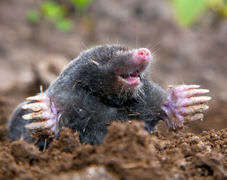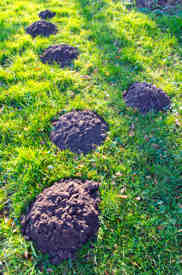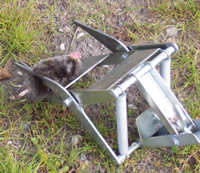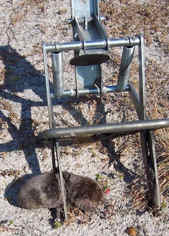Mole control is one of the most challenging tasks of maintaining the lawn and garden, but most of the traditional methods of mole control are less than satisfactory. First let’s take a look at ten mole control methods that either don’t work very well or don’t work at all, and then we will take a look at the most important considerations for the one mole control tip that can get rid of moles for good.
1. Mole deterrents are best used for keeping moles out of specific places.

Blood meal, castor oil, cayenne pepper, used chewing gum, and human hair all drive moles away from specific locations. If you are trying to keep moles away from a putting green or the valve boxes for your sprinkler system, these deterrents will probably work. The problem with using them for controlling a broader area is that they have to be reapplied on a regular basis, at least every few days, and some of them can become very expensive.
2. It is impossible to starve moles by using insecticides and vermifuges.
Some homeowners attempt to get rid of moles by getting rid the grubs they eat with insecticides and the earthworms they eat with vermifuges. This is usually a terrible idea. The poisoned bugs can kill birds. The earthworms carry humus to the roots of plants and keep the soil aerated. Even if it were possible to kill all the insects and worms in the lawn and garden, and it is not, as soon as the treatment was discontinued, moles would come back, to a landscape devastated by the homeowner rather than the moles.
3. Castor oil keeps moles out of flower beds. However, it also attracts dogs to flower beds.
Castor oil in the form of “castoria” was once the most common remedy for constipation. It induces contractions in the muscles lining the bowel that bring about regularity very quickly. In a small animal like a mole, these contractions could quickly become fatal, but moles simply avoid the oil when they smell the castor oil odor. They are not killed, but young bedding plants and bulbs are left undisturbed.
Castor oil repels moles from garden beds. Unfortunately, it attracts dogs, who eat earth or plants coated with castor oil and then develop diarrhea. Castor beans also deter moles, but they contain a deadly neurotoxin known as ricin and handling the beans is not without risk.
4. Ultrasonic units can be very effective for controlling mice and rats, but they seldom work for controlling moles.
Many animals both hear and make sounds at pitches too high for the human ear to hear. When a rat or a mouse hears these sounds near the entrance to an enclosed space, it is likely to avoid that space unless it is very hungry.
Moles are always very hungry, and they never have just a single entrance to their dens. Unless you could practically carpet your lawn with dozens of ultrasound generating units, you are highly unlikely to drive any moles away. Even then, the mole would simply dig a new tunnel and come up in a different spot.
5. Poison mole bait is more likely to kill pets than moles.
It is difficult to avoid collateral damage from poison baits, because the poison used to kill moles also kills other kinds of animals and can cause serious problems for people. Several companies make poison baits for moles. The poison of choice is warfarin, which induces uncontrollable bleeding in moles, mice, rats, squirrels, cats, dogs, and people, in different dosages. Warfarin is mixed in with the bait. There baits are either pre-formed to look like earthworms or can be squeezed out of a tube to look like earthworms. The idea is to put the poison bait out at the entrances of mole holes in the expectation that the mole will eat it and die.
Moles do not always eat the worms they catch right away. They may store up to several hundred worms in a cache in their tunnels. It is not possible to know when or whether the bait actually kills moles. Pets or children who find the poison bait, however, can become very sick very fast should they consume it.
Especially if the bait has been handled by someone who did not wear gloves or who walked out to the mole hill without wearing shoes, then the mole will leave the poisoned bait for some other animal or person.
6. Flooding tunnels only compounds damage to the landscape.

One of the most commonly used bad methods of mole control is pumping water into a tunnel in an attempt to drown the critters and their young. There is always a possibility that you will drown a mole. However, since you do not know where mole tunnels go, there is also a possibility that you will pump water under your house or into your basement, or you will create a sink hole in your lawn or garden or even underneath your home. At the very least the ground in your lawn or garden is likely to collapse everywhere the water goes.
7. Smoke bombs usually do minimal damage to the landscape and minimal damage to moles.
It’s hard to do a lot of damage by putting smoke bombs into to mole tunnels. It’s just also hard to do a lot of good. You will probably only deter a mole from coming up through that tunnel for a few hours. By the next day it is back to business as usual for the mole.
8. Burning moles out of their tunnels is usually not effective.
Not only is trying to set mole tunnels on fire with propane gas lit with a match ineffective, it is also illegal in most the United States, Canada, and the UK. Exploding propane gas incinerates everything in a mole’s burrow and explodes the soil above it. The ground falls in over the tunnel and a blast dust makes mounds at burrow entrances. There is no guarantee moles will actually be in their tunnels when the gas is lit, so the method has to be applied over a very large area. And because one never knows where mole tunnels lead, it is possible to set outbuildings, propane storage tanks, and even houses and flats afire with this method.
9. Shooting moles with firearms is also usually not effective.
Shooting a mole right between its tiny little eyes might be viscerally satisfying to some vexed homeowners, but one has to be in the right place at the right time for the method to work, and the appropriate weapon would be a shotgun, not a rifle. It is easy to damage water pipes and gas mains with shots fired into the ground, and it is illegal to discharge a firearm in most urban areas in most English-speaking jurisdictions.
10. Automobile exhaust kits for killing moles and gophers are usually a waste of time and money.
Some companies sell kits for hoses that attach to an automobile exhaust pipe to direct the fumes into a mole’s tunnels. The problem with this approach is that even if you are successful at filling tunnel with carbon monoxide and other noxious fumes, the animal may simply scurry out the other end of the tunnel. Not all tunnels are connected, so you would have to fumigate your property on a continuous basis. Unlike carbon dioxide, carbon monoxide is not heavier than surrounding air, so it can escape from the tunnels and kill both pets and people, giving the moles the last laugh.
If ten of the most common methods of attempting to control moles don’t work, what does?
The solution to keeping moles under control is trapping.

Trapping kills moles quickly and humanely. Most traps can only catch only one mole at a time, but since moles are usually solitary animals, one mole is the most you are likely to trap at any single location. No matter which trap you choose, you will need certain basic supplies:
- The trap,
- Gardening gloves (cloth, not latex),
- A small trowel or hand spade, and
- A 2.5 to 5 gallon (10 to 20 litre) bucket.
It’s essential to leave the trap in the box until you are ready to put it out. Handling the trap, especially with sweaty hands, can transfer human scent to the trap. Moles will detect your scent and scurry away to other tunnels.
You should always handle the trap with garden gloves. It is best to season the gloves by rubbing them in fresh dirt, or even better in fresh dirt that contains earthworm castings or live earthworms. The scent of earthworms also transfers to the trap and lures moles in. You should only handle the trowel and the bucket with the same gloves.
Moles do not usually leave an open tunnel. They cover their tracks with fresh dirt. The best placement for a trap is on newly disturbed soil in the middle of a mound. Some traps require placement on newly disturbed soil and some models require placement in newly disturbed soil. You will need the trowel to dig into the dirt to anchor your trap. Always orient the trap to be parallel to the path moles travel so they will not dig under or around it.

Moles are trapped coming to the surface rather than going back underground. When you have set your trap, you’ll need to cover it with a bucket so you can locate the trap and also to keep other wildlife, pets, and children out of the trap.
Because mole tunnels are extensive, you may not capture a mole every time you set the trap. Check after a day or two and move the trap to a new location if it is empty, taking care to handle the bucket and trap with gloves rather than with bare hands. Eventually you will remove most or all of the moles from your property, but you will need to continue trapping as new moles find your property and take over old tunnels.

Nice trap but I have only one question. What is the best was of dislodging the carcass from the scissors trap.
By hand but make sure you wear gloves.